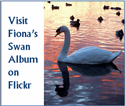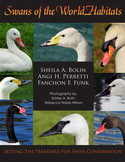Ask the Swan Specialist
Date: 17 January 2016
Hi Nancy:
Your question is rather involved and would be too long to cover in this post. Therefore, we are going to try and answer this in a concise manner and point you into a direction that you can further investigate. There are two Tundra Swan populations in the U.S. and the Eastern group seems to go north for nesting and migration.
Scientists were perplexed as to why many migrating birds flew north toward the arctic rather than flying south like other birds for nesting. The answer lies in the Arctic boreal forests and the tundra itself. During a very short spring time, the boreal forests and marshes are much warmer than at other times of the year. The surrounding waters have melted and the marshes are replete with food sources for the millions of migratory birds. The area is wide open so that birds can nest on the open ground in such a large area that they do not have to compete with other birds for the food and nesting resources. Another reason that has also been promoted is that there is no hunting in these areas. Birds and wildlife are not stupid. Once they have seen members of their flock fly out of the sky after gunfire, or see hunters in an area, they know not to go into that area. Hunting can change the migration patterns of many birds.
This is happening in Canada. Trumpeter Swans which are being introduced throughout the U.S. for Trophy Waterfowl hunting purposes, are not leaving (migrating) from Canada into the U.S. due to the hunting areas. This is causing problems in Canada as the non-migrating Trumpeters are wrecking havoc on farms and crops.
You might look up arctic boreal forests and migration of birds (Tundra Swans), etc. to understand how and why this area is so conducive to nesting birds.
Many birds including some swans have a small "spur like" growth on their legs which is nothing more than a vestige of a possible spur or other claw-like feature. Think of a human's tailbone which is a vestige of humans earlier times when a tail or such appendage was present. These vestiges serve no purpose other than a reminder of what earlier related species might have looked or needed.
A swan's temperature can range from 100-106 degrees F. Infection, heat and stress can raise the temperature. The Regal Swan
Messages In This Thread
- Tundra Swan -- Nancy -- 16 January 2016
- Re: Tundra Swan -- The Regal Swan -- 17 January 2016
Ask the Swan Specialist is powered by
Tetra-WebBBS 5.30 Beta © 2006-2007 Tetra-Team






